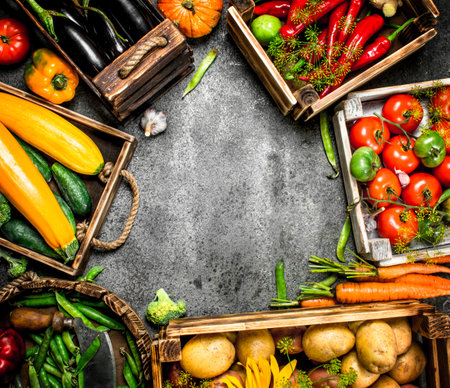1. The Benefits of Seasonal Eating for Health and Wellbeing
Seasonal eating in the UK is more than a culinary trend—it is an evidence-based approach to nutrition that aligns our diets with the natural rhythms of the local environment. By choosing foods that are harvested in their peak season, such as British asparagus in spring or blackberries in late summer, individuals benefit from enhanced nutrient density. Research demonstrates that fruits and vegetables picked at their prime contain higher levels of vitamins, minerals, and phytonutrients compared to those grown out of season or transported long distances. These locally sourced foods also tend to be fresher, having spent less time in transit and storage, which further preserves their nutritional value.
Another key advantage is cost-effectiveness. In-season British produce is often more affordable due to lower transportation costs and a reduced need for artificial growing conditions. This accessibility makes it easier for people across the UK to maintain a varied diet rich in anti-inflammatory foods—such as kale, leeks, and berries—that support immune function and reduce chronic inflammation. Moreover, aligning meals with the UK’s natural harvest calendar fosters a deeper connection with local agriculture and food heritage, encouraging sustainable choices that benefit both individual wellbeing and the environment.
Understanding Inflammation and Dietary Impact
Inflammation is a natural biological response that helps the body heal from injury or infection. However, chronic inflammation has been linked to numerous long-term health conditions, including heart disease, type 2 diabetes, arthritis, and certain cancers. In the UK, rates of these chronic diseases are rising, making it increasingly important for individuals to understand how daily habits—particularly dietary choices—can modulate inflammatory processes.
The body’s inflammatory response can be influenced by a range of factors. While genetics and lifestyle play significant roles, emerging evidence consistently highlights the impact of diet. Consuming foods rich in antioxidants, polyphenols, and healthy fats has been shown to help reduce systemic inflammation. Conversely, diets high in processed foods, refined sugars, and unhealthy fats may exacerbate inflammatory markers.
How Diet Influences Inflammatory Responses
A balanced diet that incorporates local, seasonal produce can provide an array of nutrients that support anti-inflammatory mechanisms. For example, British-grown berries are packed with vitamin C and flavonoids during summer months, while autumn root vegetables offer fibre and beta-carotene. These compounds work synergistically to neutralise free radicals and modulate immune function.
Links between Inflammation and Chronic Conditions
| Chronic Condition | Role of Inflammation | Dietary Influence |
|---|---|---|
| Cardiovascular Disease | Persistent low-grade inflammation damages blood vessels | Omega-3-rich fish, oats, leafy greens reduce risk |
| Type 2 Diabetes | Inflammation impairs insulin sensitivity | Whole grains, nuts, seasonal fruits help stabilise blood sugar |
| Arthritis | Inflamed joints cause pain & mobility issues | Berries, brassicas (e.g., broccoli), olive oil support joint health |
| Certain Cancers | Chronic inflammation contributes to cell mutation | Cruciferous veg (e.g., cabbage), garlic, onions offer protective effects |
Rational Approach to Anti-Inflammatory Eating in the UK Context
In summary, adopting a diet based on locally available and seasonal foods is not only environmentally sustainable but also offers practical benefits for managing inflammation. By consciously selecting nutrient-dense British produce throughout the year—tailored to what is naturally abundant each season—it is possible to harness the anti-inflammatory potential of food as part of a comprehensive strategy for long-term health.
![]()
3. Spring: Fresh Starts with Leafy Greens and Cruciferous Vegetables
Embracing British Springtime Bounty
As winter gives way to spring in the UK, local markets begin to brim with vibrant greens and nutrient-rich vegetables. This season is particularly significant for those seeking anti-inflammatory benefits from their diet, as British spring produce offers a unique combination of freshness and functional nutrition. Among the stars of this period are watercress, asparagus, and tender kale—each bringing its own set of health-promoting properties.
Watercress: A Peppery Powerhouse
Watercress thrives in the cool springs of the British Isles and is celebrated for its high levels of antioxidants, including vitamin C, beta-carotene, and flavonoids. These compounds are scientifically linked to reduced inflammation and improved immune response. Watercress also contains glucosinolates, which are known for supporting liver detoxification pathways. For a practical meal idea, add fresh watercress to sandwiches or toss it into early-spring salads for a peppery kick and nutritional boost.
Asparagus: A Seasonal Staple
British-grown asparagus is at its best from late April through June. Rich in folate, vitamin K, and polyphenols such as quercetin, asparagus supports cardiovascular health and has demonstrated anti-inflammatory effects in clinical research. Lightly steaming or roasting asparagus preserves these nutrients while enhancing flavour. Try pairing it with poached eggs or incorporating it into risottos for an easy way to enjoy its health benefits.
Tender Kale: Versatile and Nutrient-Dense
Kale, especially the young, tender leaves available in spring, is abundant in vitamins A, C, and K as well as manganese and omega-3 fatty acids—all associated with combating inflammation at a cellular level. Regular consumption of kale can help reduce oxidative stress and support joint health. Sauté tender kale with garlic as a quick side dish or blend it into green smoothies for an effortless nutritional upgrade.
Practical Tips for Eating Seasonally in Spring
To maximise both flavour and anti-inflammatory potential during the UK’s spring months, focus on sourcing produce from local farmers’ markets or veg box schemes. Incorporate these greens into daily meals—think soups, salads, stir-fries, or simply steamed with a drizzle of cold-pressed rapeseed oil. By prioritising seasonal British vegetables like watercress, asparagus, and kale, you not only support local agriculture but also harness nature’s most potent anti-inflammatory foods at their peak.
Summer: Berries, Tomatoes, and Omega-3 Rich Fish
British summers bring a bounty of anti-inflammatory foods that flourish under longer daylight hours and milder temperatures. Local berries, tomatoes, and oily fish stand out as seasonal stars, offering both culinary versatility and powerful health benefits tailored for the UK palate.
The Anti-Inflammatory Power of Summer Produce
Berries such as strawberries, raspberries, blackberries, and blueberries are widely available from June through August. These fruits are naturally high in anthocyanins and vitamin C—compounds shown in clinical studies to reduce markers of inflammation and oxidative stress. Tomatoes, another British summer staple, are rich in lycopene, a carotenoid linked with lower levels of inflammatory cytokines. Meanwhile, locally caught oily fish like mackerel and herring provide omega-3 fatty acids (EPA and DHA), which have a robust evidence base for their role in modulating inflammation within the body.
Key Nutritional Benefits of Summer Foods
| Food | Main Anti-Inflammatory Nutrients | Proven Health Benefit |
|---|---|---|
| Berries (strawberries, raspberries) | Anthocyanins, Vitamin C, Fibre | Reduces oxidative stress; supports immune function |
| Tomatoes | Lycopene, Vitamin C, Potassium | Decreases inflammation markers; supports heart health |
| Mackerel & Herring | Omega-3 Fatty Acids (EPA/DHA), Vitamin D | Lowers risk of chronic inflammatory diseases; supports brain function |
Simple Ways to Add Seasonal Foods to Your Diet in the UK
Incorporating these ingredients into daily meals is straightforward and aligns with traditional British eating habits:
- Porridge with fresh berries: Top morning oats with seasonal strawberries or blueberries for a fibre-rich start.
- Tomato salads or sandwiches: Use ripe British tomatoes in salads with local greens or sliced into a classic sandwich with wholemeal bread.
- Mackerel pâté on oatcakes: Blend smoked mackerel with low-fat yoghurt and herbs for an easy spread on Scottish oatcakes.
- Grilled herring with new potatoes: Serve grilled oily fish alongside seasonal veg for a balanced dinner.
This mindful approach to summer eating leverages the peak freshness and nutritional density of British produce while supporting ongoing inflammation management—a strategy both rooted in evidence-based nutrition and woven into the fabric of everyday UK cuisine.
5. Autumn: Root Vegetables, Brassicas, and Hearty Pulses
As the days shorten and temperatures drop across the UK, autumn’s landscape is defined by an abundance of robust, nutrient-dense produce. This season sees local markets brimming with root vegetables such as parsnips and beetroot, brassicas like Brussels sprouts, and hearty British-grown pulses including lentils. These foods are not only pillars of traditional British cuisine but also provide significant anti-inflammatory benefits and nutritional diversity.
Root Vegetables: Parsnips and Beetroot
Parsnips are rich in vitamin C (17 mg per 100g), potassium, and soluble fibre, all of which support immune function and cardiovascular health. Their subtle sweetness enhances both savoury roasts and warming soups—staples in British kitchens as the weather cools. Beetroot stands out for its high content of betalains, known for their antioxidant and anti-inflammatory properties. A 100g serving offers around 20% of your daily folate requirement, essential for cellular repair and mental wellbeing.
Brassicas: The Power of Brussels Sprouts
Brussels sprouts—often divisive on festive plates—are nutritional powerhouses. Containing 85 mg of vitamin C per 100g (more than an orange), they also offer vitamin K, folate, and glucosinolates which have been linked to reduced inflammation and cancer risk. Their culinary versatility allows them to be roasted, sautéed or even shredded raw into salads.
Pulses: British-Grown Lentils for Protein and Fibre
Lentils grown in the UK are gaining prominence due to their low environmental impact and high nutritional value. One cooked portion (80g) provides approximately 6g protein, 5g fibre, and important minerals such as iron (1.2mg) and magnesium (20mg). Incorporating lentils into stews or shepherd’s pie boosts both satiety and heart health while supporting local agriculture.
Culinary Inspiration for a Nourishing Autumn
The combination of these seasonal ingredients supports a diet high in phytonutrients, antioxidants, and gut-friendly fibre—elements that help reduce chronic inflammation associated with modern lifestyles. Embracing autumn’s harvest not only connects you to the rhythms of the British countryside but also aligns your eating habits with evidence-based nutritional strategies for long-term wellbeing.
6. Winter: Embracing Storage Crops and Warming Spices
Winter in the UK is synonymous with hearty, comforting dishes that make use of robust storage crops and warming spices. While the landscape may appear sparse, traditional British winter fare provides ample opportunity to maintain an anti-inflammatory diet by focusing on locally-sourced root vegetables, leeks, and seasonally-appropriate spices.
Root Vegetables: The Backbone of Winter Nutrition
British root vegetables such as carrots, parsnips, swedes, and turnips are rich in fibre, vitamin C, and antioxidants. These nutrients help regulate inflammation by supporting immune health and reducing oxidative stress. Roasting or steaming these veg retains their nutrient density while providing natural sweetness and depth to winter meals. Additionally, potatoes—when enjoyed with their skins—offer potassium and resistant starch which support gut health and a balanced inflammatory response.
Leeks: A Versatile Allium for Gut and Immune Health
Leeks, a staple in classic British soups and stews, are part of the allium family. They contain prebiotic fibres that nurture beneficial gut bacteria and contribute to a healthy immune system. Their gentle flavour makes them ideal for pairing with other winter vegetables or as the hero ingredient in dishes like leek and potato soup—a comfort food with proven anti-inflammatory benefits thanks to its antioxidant content.
Warming Spices: Culinary Tradition Meets Functional Benefit
The colder months see an increased use of warming spices such as ginger, turmeric, cinnamon, and black pepper in British kitchens. These ingredients do more than add flavour; they have well-documented anti-inflammatory properties. For example, curcumin in turmeric can modulate inflammatory pathways, while gingerols in ginger help reduce markers of inflammation. Adding these spices to porridge, stews, or roasted veg blends culinary tradition with functional health benefits.
Traditional Winter Dishes: A Foundation for Anti-Inflammatory Eating
Many beloved British winter dishes—such as vegetable casseroles, slow-cooked stews, or roasted root medleys—naturally fit into an anti-inflammatory framework when prepared with minimal processed fats or sugars. By choosing whole ingredients and using local produce, you not only support your own wellbeing but also reinforce sustainable food systems within your community.
In summary, embracing seasonal winter eating in the UK offers a practical and culturally relevant approach to reducing inflammation through diet. By prioritising storage crops like root vegetables and leeks alongside beneficial spices, you can enjoy comforting meals that nourish both body and mind during the colder months.
7. Practical Tips for Incorporating Seasonal, Anti-Inflammatory Foods in a UK Diet
Adopting a seasonal, anti-inflammatory diet in the UK doesn’t require a complete lifestyle overhaul. By making small, intentional changes and embracing local produce, you can enjoy both health benefits and culinary satisfaction all year round. Here are some practical strategies to get started:
Sourcing Local and Seasonal Produce
Visit Local Markets and Farm Shops
Frequenting farmers’ markets and independent greengrocers not only supports British growers but also ensures you’re buying the freshest, most nutrient-rich fruits and vegetables available each season. Many farm shops highlight what’s currently in season and may even provide recipe ideas.
Join a UK Veg Box Scheme
Consider subscribing to a veg box delivery from regional farms or community-supported agriculture (CSA) initiatives. These schemes curate weekly or fortnightly boxes packed with freshly harvested produce, often prioritising organic and regenerative farming practices.
Prepping for Ease and Variety
Batch Prep and Freeze
To make seasonal eating more convenient, set aside time to wash, chop, and portion your veg for easy access throughout the week. Blanching and freezing surplus produce—like berries in summer or greens in spring—helps reduce waste and maintains nutritional value for use during leaner months.
Experiment with Simple Cooking Methods
Embrace British classics like roasting root vegetables with rapeseed oil or simmering hearty stews using winter brassicas. Steaming, grilling, and lightly sautéing help retain nutrients in anti-inflammatory foods such as kale, purple sprouting broccoli, or beetroot.
Enjoying Seasonal Meals within Everyday Life
Create Easy Meal Plans Around What’s Available
Base your weekly meals on what’s most abundant at the market. Swap imported ingredients for homegrown alternatives: think replacing out-of-season tomatoes with roasted squash or beetroot in salads or sandwiches.
Add Herbs and Spices for Extra Benefits
Boost the anti-inflammatory potential of your dishes by adding British-grown herbs like parsley, mint, or thyme, along with spices such as turmeric or ginger (often available fresh in larger supermarkets).
Stay Mindful of Food Waste
Use up vegetable trimmings in homemade stocks or soups, and compost what you can’t use. Seasonal eating naturally encourages resourcefulness—a trait long valued in British kitchens.
By integrating these practical tips into your routine, you’ll find that enjoying local, anti-inflammatory foods becomes both achievable and rewarding within the rhythm of everyday British life.


